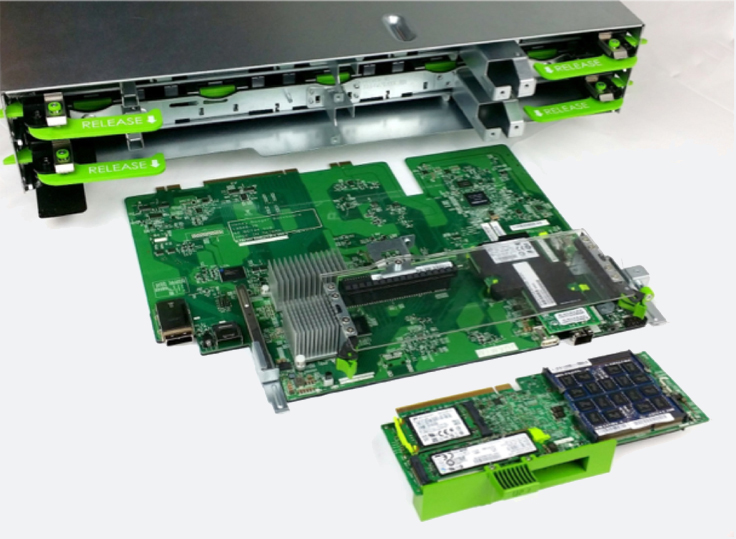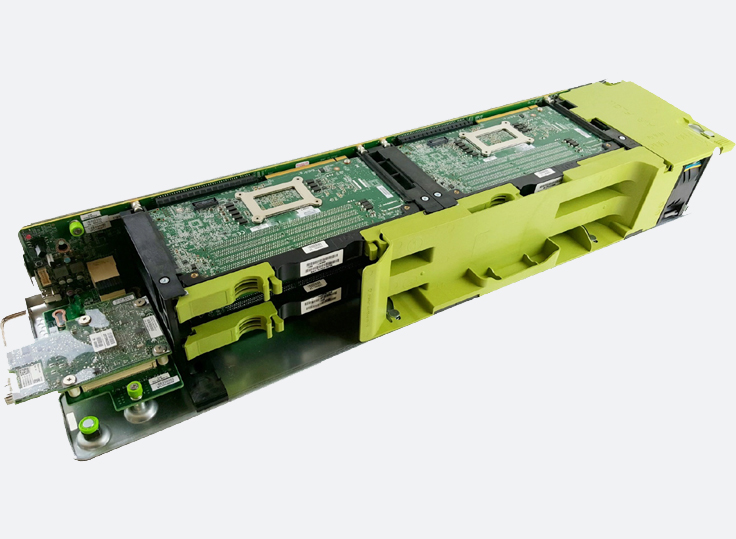Facebook’s data centers are among the most advanced, energy-efficient facilities in the world. Ever since we broke ground on our first data center, we have been focused on powering connectivity with the smallest footprint possible. Moving our electricity supply to clean and renewable sources is a big part of that, helping to reduce pollution from the energy we consume. We met our initial goal of sourcing 25 percent renewable energy in 2015, and have doubled that goal to 50 percent by the end of 2018. Efficient hardware and mechanical systems are another big part, as they help us minimize the amount of energy we use.
While reducing the impact of our energy consumption is important, it’s not enough. As we’ve grown, so has our perspective on sustainability, particularly when it comes to how we design our data centers and hardware. We’re approaching sustainable hardware design by looking at the entire life cycle (raw material extraction → manufacturing → transport → use → end of use → reuse or recycling) with the goal of reducing fossil fuel inputs and emissions. In addition to sourcing renewable energy, we make sure our gear is shipped responsibly to and from the data centers and disposed of properly at the end of its use. Our engineers have also incorporated a “low vanity” design philosophy, which means we eliminated any material that did not serve a specific function for the server, saving cost and reducing the overall material footprint. Our next step was to evaluate the material feedstocks going into the designs of our hardware.
The bulk of the mechanical materials in our hardware are steel and plastic. We focused on our use of PCABS, a common petroleum-based plastic, and looked for an alternative material that could reduce the non-renewable inputs into our system. After looking at a variety of materials and potential part applications, and a lot of iteration, we found our solution in natural fiber-filled polypropylene (NFFPP).
NFFPP has been used in a number of other industries, including the automotive industry, and research into the use and application of the material has shown it to be in line with our goals of reducing our dependency on fossil fuels. The renewable natural fibers come from a jute fiber. They are mixed with polypropylene granulate and a non-halogenated flame retardant (which is more environmentally friendly) to help the material achieve a UL94 V-0 flammability rating. The material can be bio-based certified, depending on the natural fiber content.
Today, we use NFFPP in a number of our data center products that are available through the Open Compute Project:
- Lightning
- Honey Badger
- Yosemite (converted from PCABS using PCABS tooling with minor tweaks)
- Open Rack (bus bar cover and cable clips)
- Knox (HDD adapters)
- Leopard

(Honey Badger)

(Yosemite)
Using NFFPP reduces the upstream carbon footprint (from raw material extraction through manufacturing) by more than 50 percent compared with PCABS, and it performs quite well in this area compared with other common plastics, such as polycarbonate (PC) and glass-filled PET. Going forward, we plan to use NFFPP everywhere we can in future data center hardware designs.
NFFPP development
We wanted to use a more environmentally friendly material without sacrificing the design and performance benefits of PCABS. We had to make some adjustments in the material, design, and manufacturing processes to ensure that we could use existing PCABS tooling to make NFFPP parts.
Material properties
We wanted to develop resins with the UL94 V-0 flammability rating while matching the shrinkage rate of common PCABS. This was important in making sure we could use existing tooling for parts. We succeeded in both goals: The material is available in V-0, V-1, and V-2 ratings, and its shrinkage is effectively the same as PCABS, so it can be used in most cases with PCABS tools, with some adjustments. The ratio of natural fiber to polypropylene to flame retardant can be varied to achieve desired stiffness and other mechanical properties.
Design
With regard to part design, NFFPP adheres closely to the design rules for other composites containing fibers, such as glass fiber or carbon fiber–reinforced plastics. One such similarity is that tooling may require more gates, or holes where the liquid material flows through, for better fiber flow. Large, evenly distributed gates will help in holding pressure and reducing cosmetic surface fiber streaks. Adding grid ribs on thin, long, or large-area flat parts; ensuring sufficient draft angles; and evenly distributing ejector pins can help reduce warping.
Molding process
The mold settings used for other materials cannot be used for NFFPP. Unlike PCABS, NFFPP needs a well-tuned initial setup procedure, which includes measuring the couplings, interior mold temperatures, injection barrel temperature, and material temperature, and ensuring that there are sufficient thermocouples. Pellets must be dried to release trapped moisture, although this issue is purely cosmetic. The following parameters should be considered:

Cosmetics
The nature of the fiber fill allows fiber flow marks to be seen on the surface of the part, and is most noticeable in non-tinted resins. If coloring NFFPP is necessary, polypropylene paint can be used as a reference. It may be necessary to flame-treat the surface and add texture before painting. In our experience, we were able to pass the nail-scratch test, but the criss-cross scratch test results were marginal.

One particularly interesting product is Yosemite, our 2U 4-CPU server sled that fits in the OCP cubby shelf in an OCP V2 rack. It was originally designed to use PCABS for all parts, including the structures, latches, motherboard mounts, and air baffles. To use the existing PCABS tooling to mold the parts, we had to make some adjustments to the operating parameters. In addition to the NFFPP mold process, we also needed to add some ribs to prevent wide, thin parts from warping; we reduced the height of tall, thin walls by 30 percent; we thickened some snap features; and we added a fan gate to the fan tray air baffle to prevent warping. Additionally, each part needed to have the mold setup configurations dialed in, which involved doing test shots while making adjustments. Save for one small nylon part, we were able to convert every Yosemite part to NFFPP.
At Facebook, it was important to expand our concept of efficiency beyond “low vanity” design (or de-materialization of the server) and the power that runs our data centers; this example of deploying NFFPP in our hardware programs demonstrates one way we explored this idea. We have learned a lot throughout the process and plan to continue experimenting with ways we can reduce the overall environmental footprint of our infrastructure.
For an example of how NFFPP is being used in our hardware, you can find more information in the Honey Badger hardware specification on the OCP website.









